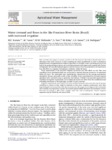Please use this identifier to cite or link to this item:
http://www.alice.cnptia.embrapa.br/alice/handle/doc/631354| Title: | Water demand and flows in the São Francisco River Basin (Brazil) with increased irrigation. |
| Authors: | MANETA, M. P.  TORRES, M.   WALLENDER, W. W.   VOSTI, S.   KIRBY, M.   BASSOI, L. H.   RODRIGUES, L. N.   |
| Affiliation: | M. P. MANETA, University of California M. TORRES, University of California W. W. WALLENDER, University of California S. VOSTI, University of California M. KIRBY, CSIRO LUIS HENRIQUE BASSOI, CPATSA LINEU NEIVA RODRIGUES, CPAC. |
| Date Issued: | 2009 |
| Citation: | Agricultural Water Management, v. 96, n. 8, p. 1191-1200, 2009. |
| Description: | Most activities that support economic growth in the São Francisco Riber Basin (Brazil) need water. Allocation of the water resources to each competing use needs quantification in order to develop an integrated water management plan. Irrigation agriculture is the largest water consuming activity in the basin. It has produced large economic and social advancements in the region and has potential for further development. The local development agency in the São Francisco River has projected an increase of more than 500,000ha in irrigation developments distributed within the basin. Water requirements of the projected irrigation expansions and their effects on river flow were quantified. A semi-distributed model was constructed to simulate the water balance in 16 watersheds within the basin. The watersheds were hydrologically characterized by the average precipitation, atmospheric demand and runoff as well as their variability. Water requirements for increased irrigated agriculture were calculated using an agronomic mas balance. A Monte Carlo procedure generated the variability of irrigation requirements and resulting decreased river flows from the multidimensional probability distribution of the hydrologic variables of each watershed. Irrigation requirements were found to be more variable during the wet season because of weather variability. In contrast to what might be expected, in drier years, irrigation requirements were often larger during the wet season than in the dry season because the cropped area is largest in the wet months and variability of precipitation is greater. Increased irrigation shifted downward the distribution of river flows but not enough to affect other strategic water uses such as hydropower. Further irrigation expansion may be limited by wet season flows. |
| Thesagro: | Irrigação Manejo de Água |
| NAL Thesaurus: | Irrigation Water resources Water management |
| Keywords: | Bacia do São Francisco Rio São Francisco Projeto de desenvolvimento integrado Variability of irrigation |
| ISSN: | 0378-3774 |
| DOI: | 10.1016/j.agwat.2009.03.008 |
| Type of Material: | Artigo de periódico |
| Access: | openAccess |
| Appears in Collections: | Artigo em periódico indexado (CPATSA)  |
Files in This Item:
| File | Description | Size | Format | |
|---|---|---|---|---|
| Bassoi3.pdf | 655,88 kB | Adobe PDF |  View/Open |









